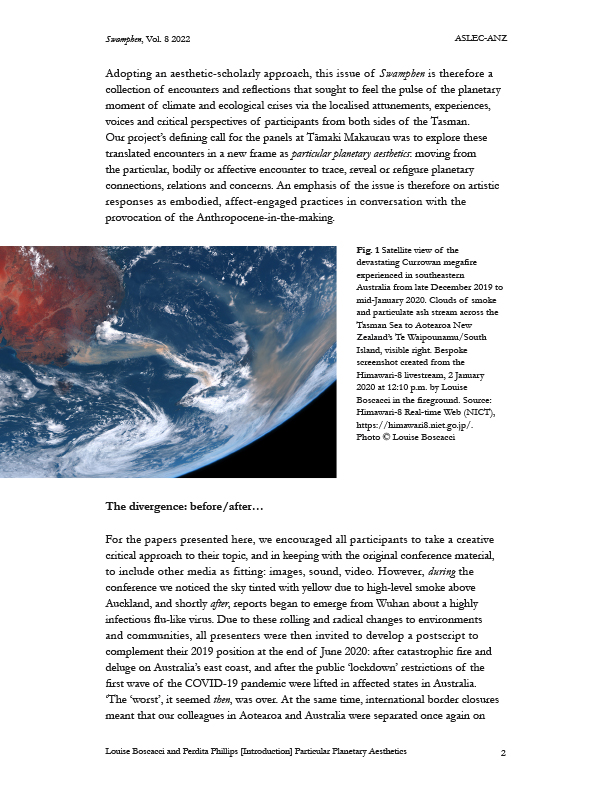Particular Planetary Aesthetics
DOI:
https://doi.org/10.60162/swamphen.8.16686Keywords:
particular planetary aesthetics, contemporary art and writing, affective encounters, more-than-human, Anthropocene-in-the-making, feminist environmental humanities, planetarity, Gayatri Spivak, multispecies entanglement, COVID-19, practice as researchAbstract
Particular Planetary Aesthetics is the title and theme of this Swamphen special issue. It has its origins in Ngā Tūtaki – Encounter/s: Agency, Embodiment, Exchange, Ecologies, the 2019 conference of the Art Association of Australia and New Zealand (AAANZ) held in Tāmaki Makaurau Auckland, Aotearoa. For this special cross-Tasman event, and from opposite coasts of Australia, we convened panels for participants under two invitational titles: “Affective Encounters, Shadow Traces, and Resonant Naturecultures in the Anthropocene: Particular-planetary aesthetics in the feminist ecosocial turn” and “Encounters with and within the Anthropocene: Speculating on Particular-Planetary Aesthetics.” Our project averred that the work of art in the Anthropocene was under interrogation by contemporary artists, writers, theorists and historians. Connected with this shifting ground, we argued that new energies and collaborations were emerging across the postconventional arts and ecological humanities, creating alternative critical frameworks to engage with: that the human is more-than-human and the social is an eco-social domain in a preternatural age of extinction and climate destruction. We set out to feel the pulse of what contemporary artists and researchers from Aotearoa and Australia were doing, making, speculating on, or writing about in the push and pull—the effects, affects and implications—of the Anthropocene-in-the-making. Our project’s defining call was to explore encounters in a new frame of particular planetary aesthetics: moving from the particular, bodily or affective encounter to trace, reveal or refigure planetary connections, relations and concerns.
In this guest editorial note, we write in the wake of the ravages of climate crisis fires in Australia, as well as the borderless COVID-19 pandemic. We flesh out the project in its beginnings above, and introduce eleven papers and three visual portfolios of art research in practice that respond to our provocations before and after the Auckland conference. Collectively these scholarly and aesthetic works consider, trace, and respond to affective encounters of the particular and the planetary in the capricious spaces of the Anthropocene-in-the-making.

Downloads
Published
Issue
Section
License
Authors who publish with this journal agree to the following terms:- Authors retain copyright and grant the journal right of first publication with the work simultaneously licensed under a Creative Commons Attribution License that allows others to share the work with an acknowledgement of the work's authorship and initial publication in this journal.
- Authors are able to enter into separate, additional contractual arrangements for the non-exclusive distribution of the journal's published version of the work (e.g., post it to an institutional repository or publish it in a book), with an acknowledgement of its initial publication in this journal.
- Authors are permitted and encouraged to post their work online (e.g., in institutional repositories or on their website) prior to and during the submission process, as it can lead to productive exchanges, as well as earlier and greater citation of published work (See The Effect of Open Access).
